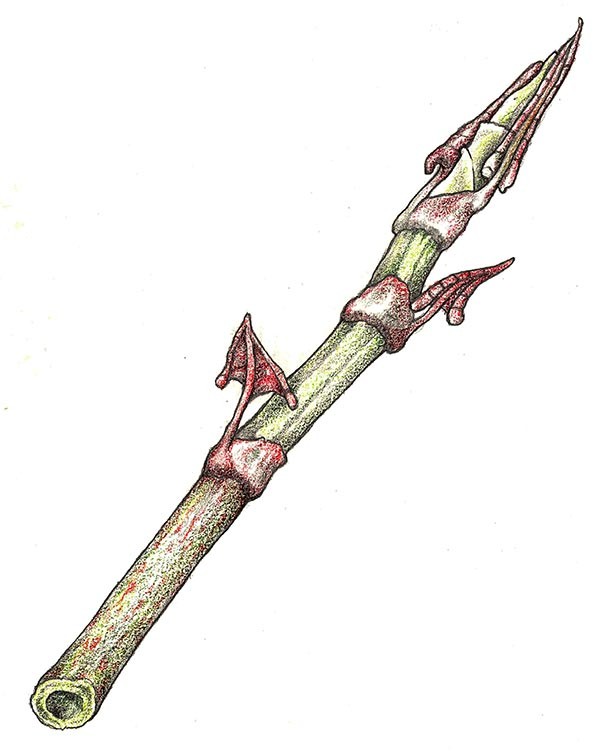Occasionally I read articles that tout the edibility of invasive wild plants and urge readers to “eat the invasives.” All it may take to manage invasive species, they suggest, is to develop a taste for them. It’s an appealing notion. After all, humans have a history of eating species into extinction. But the idea of eating our way out of the ecological chaos caused by invasive species is impractical, to put it kindly; Japanese Knotweed (Fallopia japonica) illuminates why.
Knotweed, whose hollow, jointed stems remind many of bamboo, grows in dense thickets several meters tall – tellingly, it was first planted in the US as a privacy hedge. It has large, egg-shaped leaves with squared bases. In the summer, its tiny, white flowers are fragrant and prolific. In the fall, the dried remnants of these stems are an easy tell for where shoots will appear in spring. This is useful to the forager as the young, tender shoots are the best parts for eating.
When these shoots are about one hand high, they can be snapped off and steamed or boiled. Taller stems become increasingly tart. Up to about a foot, Japanese knotweed stems are still tender and can be used if the thin, purple-spotted skin is peeled. Many wild food manuals compare them to asparagus, but this is misleading. About the only thing that knotweed and asparagus have in common is the fact that they both have edible shoots. Unlike asparagus, knotweed shoots are tart, with a distinctive earthy undertone.
It would be a poor choice to substitute knotweed for asparagus in any recipe that I know. A better comparison would be rhubarb, but I am also cautious about substituting knotweed for rhubarb in recipes. Knotweed has a flavor all its own.
As with any new food, it is best to start simply. Get to know its taste and experiment with preparations that honor knotweed’s distinct flavor. The savory flavors of Asian cuisine are a good match, and so are sweet dishes that benefit from knotweed’s tartness. The accompanying recipe for Japanese knotweed crisp would be a good place to start.
Knotweed is everywhere. Travel along any riverbank in our region and you’re bound to find some, but it also occurs in lawns, fencerows, roadways, and waste ground. As an invasive, knotweed is pernicious and famously hard to eradicate, a process that may take years of diligent effort. Harvesting knotweed as food seems like an appealing way to control its spread, but there are real limitations to this approach. Gathering a meal’s-worth of shoots has little impact. Knotweed primarily spreads by underground rhizomes that are unaffected by the loss of a few shoots.
Large-scale harvest of knotweed would require a market demand that would be hard to inspire. Even if there were such demand, knotweed’s powerful tartness would move most people to consume small quantities, the way we do with rhubarb. There have been campaigns to encourage demand for invasive species as food, but one wonders how cultivating invaders to meet a manufactured demand will lead to less and not more of something.
I enjoy knotweed as a food, but I am also concerned about its effect on our landscape. I don’t believe that my appetite for its shoots can replace more robust conservation efforts. Controls like plastic smothering, repeated mowing, or the judicious use of glyphosate herbicides have proven to be much more effective at controlling Japanese knotweed populations. Until it is eradicated, I’ll continue to enjoy its savory tartness each spring.
Strawberry-Knotweed Crisp
INGREDIENTS
3 cups frozen strawberries
1 cup knotweed stalks cut into thick coins
1/2 cup all-purpose flour
1/2 cup whole oats
1/2 cup brown sugar
1/4 cup butter
pinch of each of baking soda, baking powder, salt
cinnamon to taste
Preheat oven to 350 degrees. Mix the dry ingredients and cut in the butter. Spread half of this crumb mixture on the bottom of a greased 9 x 9 pan. Spread the strawberries and knotweed over this and place the remaining crumb over the top. Bake 40 minutes or until lightly browned.



Discussion *